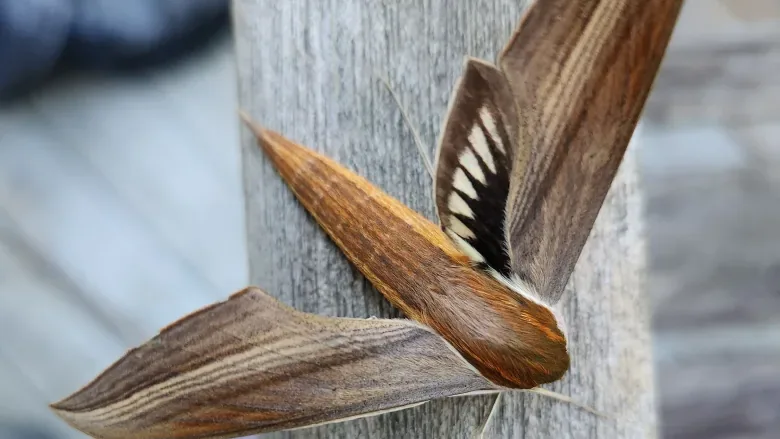
New-to-the-Maritimes moth finds its way to N.B. in hurricane season
Tropical storms can bring debris, fallen trees and flooding to New Brunswick — but they can also bring new species.
And for University of New Brunswick biodiversity and wildlife professor Graham Forbes, a species never-before-seen in the Maritimes landing in his driveway after Fiona was "a bit of luck."
SEE ALSO: Buzzworthy news: Bees observed playing
It was the day after post-tropical storm Fiona hit, Sept. 25, and Forbes almost stepped on something in his driveway. He quickly identified it as some type of sphinx moth due to its size but he didn't recognize this one.
He grabbed a field guide on moths and realized he had found a tersa sphinx moth, only really found in southern areas from Virginia to Florida.
"It wasn't something you would expect to see in the Maritimes," said Forbes.
Sphinx moths are about two-and-a-half to three centimetres long with a wing span of three to four centimetres, said Forbes.

University of New Brunswick biodiversity and wildlife professor Graham Forbes found a tersa sphinx moth in his driveway the day after post-tropical storm Fiona hit. This is the first time the species was recorded in the Maritimes. (Graham Forbes)
He said there are quite a few types of sphinx moths in the Maritimes and they fly during the day or night. The moth Forbes found had a pointed tail and alternating yellow and black markings on its underwing.
He thought it moth might be special so he contacted the Atlantic Canada Conservation Data Centre.
"I emailed them wondering if this was a special species for New Brunswick, because sometimes in the field guides there are old information and maybe the species has since established in the Maritimes," said Forbes.
He also emailed the New Brunswick Museum for their input. They emailed back saying it was unique for the area.
WATCH: Moth not seen since 1912 found in airport luggage and intercepted
The conservation data centre told Forbes that five or six Trindade petrels, a type of bird, were also reported in Cape Breton, N.S. after the storm, so the tersa sphinx moth wasn't the only species making its way to the Maritimes.
The particular moth in Forbes' driveway was injured and couldn't fly. So since he knew it wouldn't be able to make it back to its southern home and that it had a small likelihood of survival, he kept it for the museum.
Climate change may bring more southern species
Donald McAlpine, the New Brunswick Museum curator of zoology, was unable to do an interview. But in a statement, he said hurricane season often carries southern species like birds and flying insects north of their homes.
He said this includes the least tern, a bird about the size of a mockingbird, and the black witch moth, which is native to southern United States and Brazil.
McAlpine said staff are always interested in hearing about species that people find that might not be native to the province. He said these occurrences will likely increase.

Donald McAlpine, curator of zoology at the New Brunswick Museum, said hurricane season often carries southern species like birds and flying insects north of their homes. (Brian Chisholm/CBC)
"With the increase in hurricanes due to climate change we should expect more of these southern species to appear in New Brunswick in the future," said McAlpine in the statement.
Forbes said he suspects all kinds of species blew into the Maritimes with post-tropical storm Fiona, but with insects, he said few people are actively looking for them.
He said if people see a species they don't recognize, the internet is a great place to try to identify it. If someone finds a unique species to the region that they've identified to the best of their ability online, Forbes suggests emailing a photo to the New Brunswick Museum.
He said if it is unique to the area, they'll be able to record where it was seen and when, which will help "build up our natural history knowledge for the province."
The story, written by Hannah Rudderham, was originally published for CBC News.










